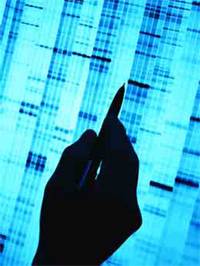The ability to identify a suspect from fingerprints left at a crime scene has been possible for more than a century. Fingerprint evidence has one big advantage over DNA profiling - it can identify an individual.
Here is the reason why a DNA profile cannot categorically identify an individual.
A set of components or 'loci' on the DNA molecule is used to generate a profile. These particular loci have been chosen for forensic purposes because they are known to show considerable variation between individuals.
The loci essentially represent a sample of a person's complete DNA profile.
Relatives will share some DNA, of course. However, there is a theoretical possibility that unrelated people will share the same DNA because the profile is, technically, a sample and not the complete profile.
The loci essentially represent a sample of a person's complete DNA profile.
Relatives will share some DNA, of course. However, there is a theoretical possibility that unrelated people will share the same DNA because the profile is, technically, a sample and not the complete profile.
Therefore, a DNA profile generated for forensic purposes will not be unique to an individual.
 |
| Photo courtesy of www.all-about-forensic-science.com |
If the DNA profile of a suspect matches the profile generated from a crime scene stain, the scientist will express their opinion as to how likely it is that somebody else's DNA would match the crime scene stain.
If there is no reason to think that any of the suspect's relatives could have left the crime scene stain, then the scientist will say (in the UK) that if the DNA match between the suspect and the crime scene stain came from some unknown person unrelated to the suspect, the probability of a match would be one in a billion.
In other words, it is highly unlikely to be anybody other than the suspect's DNA at the crime scene - but the scientist does not state it actually is the suspect's DNA.
So, although DNA evidence remains a hot topic in forensics - and DNA profiling is highly discriminating - good old-fashioned fingerprint evidence is still able to attract research funding, particularly in relation to latent or 'hidden' prints.
Although there are a number of techniques to enhance latent fingerprints, only 10% of those left at a crime scene contain sufficient detail for identification. Put another way, 90% of latent fingerprints found at a crime scene cannot be used as evidence in court.
Is anybody addressing this problem? Well, yes they are.
Is anybody addressing this problem? Well, yes they are.
I want to share an article with you about a new way of visualizing latent fingerprints on metal.
Gun and knife crimes are the scourge of the 21st century. This new technique is particularly applicable to these offences, as knives, guns and bullet casings all have metal surfaces.
Here is the link:
The researchers used colour-changing fluorescent films to enhance latent prints on metal surfaces.
Although the technique is still at the experimental stage, it looks very promising for the future.
Advances in DNA may have revolutionised forensic science and crime scene investigation, but there is always room for looking at old methods with new eyes. Maximising fingerprint evidence will always be high on the list of research projects for the foreseeable future.
Advances in DNA may have revolutionised forensic science and crime scene investigation, but there is always room for looking at old methods with new eyes. Maximising fingerprint evidence will always be high on the list of research projects for the foreseeable future.
Which areas of forensic science would you like to see evolve in the future? Do you think the advent of new techniques make creating crime fiction easier or more difficult?
No comments:
Post a Comment